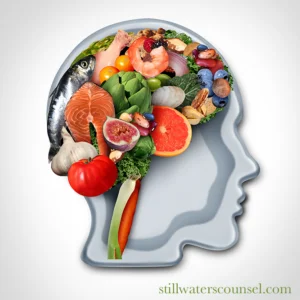Protein is a macronutrient that is essential for both physical and mental health. Protein is made up of amino acids, which are the raw materials the body uses to produce neurotransmitters, e.g. the chemicals that allow nerve cells in the brain to communicate with each other.
Neurotransmitters such as serotonin, dopamine, and norepinephrine play a key role in mood, energy, and cognitive function. Low levels of these neurotransmitters have been linked to mental health conditions such as depression and anxiety.

Protein-rich foods can help in a number of ways:
- By increasing the production of neurotransmitters. Protein provides the amino acids that the body needs to produce serotonin, dopamine, and norepinephrine. These neurotransmitters are involved in regulating mood, energy, and motivation. You can’t build a house without lumber, and you can’t make neurotransmitters without protein.
- By stabilizing blood sugar levels. Protein helps to keep blood sugar levels stable, which can prevent mood swings and energy crashes. Oftentimes the symptoms folks associate with anxiety or depression are simply the result of big swings in blood sugar. Keeping blood sugar even is a relatively simple way to minimize these symptoms.
- By reducing inflammation. Inflammation has been linked to a number of mental health conditions, including depression and anxiety. Protein can help to reduce inflammation by boosting the immune system and promoting cell repair.
If you are struggling with low mood or low energy, it is important to make sure that you are getting enough protein in your diet. Good sources of protein include lean meats, poultry, fish, eggs, dairy products, legumes, nuts, and seeds.
Ideally, you want to consume 1 gram (g) of protein per pound of body weight, no more than about 50g per meal (this is the most the body can process and use at one time). This amount of protein supports maintenance of muscle mass throughout the lifespan in addition to providing adequate material for the brain and central nervous system for mental health and wellness.
Foods with the highest amount of protein per serving include:
- Chicken breast (3-ounce serving): 27 grams
- Pork (3-ounce serving): 27 grams
- Turkey breast (3-ounce serving): 26 grams
- Beef (3-ounce serving): 26 grams
- Greek yogurt (1 cup): 24 grams
- Tuna (3-ounce serving): 22 grams
- Salmon (3-ounce serving): 19 grams
- Lentils (1 cup cooked): 18 grams
- Edamame (1 cup cooked): 18 grams
If you maintain a plant based diet, the best whole-food vegan sources of protein include:
- Beans and lentils
- Black beans (1 cup cooked) – 15g protein
- Kidney beans (1 cup cooked) – 15g protein
- Pinto beans (1 cup cooked) – 15g protein
- Black-eyed peas (1 cup cooked) – 14g protein
- Lentils (1 cup cooked) – 18g protein
- Soy products
- Tofu (1/2 cup firm tofu) – 10g protein
- Tempeh (1/2 cup) – 15g protein
- Edamame (1/2 cup cooked) – 8.5g protein
- Nuts and seeds
- Peanuts (1/2 cup roasted) – 13g protein
- Almonds (1/4 cup) – 7g protein
- Hemp seeds (1/4 cup) – 10g protein
- Chia seeds (1/4 cup) – 5g protein
- Whole grains
- Quinoa (1 cup cooked) – 8g protein
- Other foods and food products
- Seitan (3.5 ounces) – 25g protein
- Nutritional yeast (2 tablespoons) – 8g protein
- Vegan protein powder (1 scoop) – 15-25g protein
Quick ‘tofu scrambles,’ ‘buddha bowls’ (quinoa base with beans, tofu/tempeh, veg, and preferred dressing or sauce), soups, stews, and chili are great ways to increase protein intake. With a crockpot, soups/chili are excellent ‘set it and forget it’ options. The Minimalist Baker has a variety of chili and soup recipes available (in addition to many other recipes)
If you struggle to get enough protein throughout the day, shakes and bars can be a great option, provided they’re low in added sugars, and provide at least 15-25g of protein per serving. Any protein powder can simply be added to water or plant based milk. Alternatively, you can make a simple smoothie by adding your protein powder to a blender with 8-12 oz of water or plant based milk along with a banana, a cup of berries, and a handful of mixed greens for an extra boost of nutrition.
As you’re adjusting your protein intake, track how much you’re getting in for a few days out of the week (weekday and weekend). Also take note of how you feel, by way of keeping track of symptoms on a scale of 0-10, 0 being none, and 10 being high. Some symptoms you might want to keep track of include:
- Energy
- Sleep (quantity and quality)
- Mood
- Motivation
- Anxiety
- Focus
- Brain fog
- Any other symptoms that have been notable/troublesome for you.
Dietary changes are an ongoing effort, and you’ll naturally make changes with more attention and experience. Keep an experimental mindset, along with a healthy dose of self compassion as you go!
If you’re looking for individualized advice on supporting your mental health, schedule an appointment with Dr Katherine.
